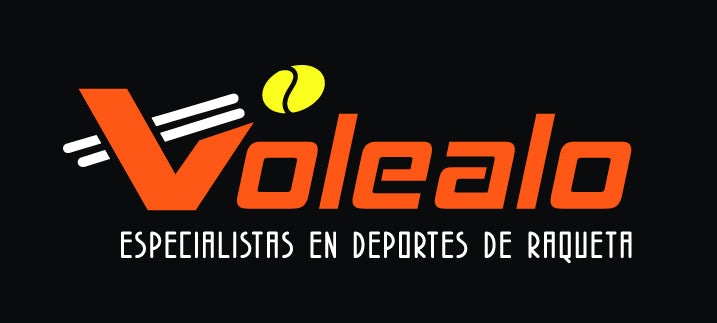Choosing the right tennis racket for a young player is not simply a matter of design or brand. It is a fundamental decision that directly impacts their physical development, their performance in the game, and their motivation to keep training. Especially during growth stages, the weight of the racket can make the difference between healthy progress and possible short- or long-term injuries. Additionally, we will recommend some products available on our website volealo.com that suit each stage of the player.
👦 Physical development: a key factor
During childhood and adolescence, players' bodies are constantly changing. Bones, muscles, and joints are still forming, so any sports equipment they use must adapt to their physical constitution.
Using a racket that is too heavy or too light can cause muscle imbalances, affect posture, and force movements that, in the long run, can lead to injuries or poor performance. A well-chosen racket should support the body rather than demand too much from it.
⚠️ What happens if the racket does not have the right weight?
Too heavy racket:
- Higher risk of injuries to the wrist, elbow, or shoulder.
- Less maneuverability.
- Difficulty generating speed in the stroke.
- Muscle fatigue during training or competition.
Too light racket:
- Lack of stability and control in strokes.
- Less power.
- Difficulty absorbing the impact of the ball.
- Risk of adopting incorrect technique.
Both extremes can hinder the player's progress and reduce their confidence.
📏 How to choose the ideal racket weight for a young player?
Below is a general guideline. It is always recommended that the player try the racket and, if possible, consult with a coach or specialist.
| Player's age | Recommended racket length | Approximate weight |
|---|---|---|
| 5-6 years | 19” to 21” | 170-200 g |
| 7-8 years | 23” | 200-225 g |
| 9-10 years | 25” | 230-250 g |
| 11-12 years | 26” | 250-270 g |
| 13+ (pre-adolescents and up) | 27” (light adult) | 270-290 g |
These values may vary depending on the player's physique and technical level.
✅ Benefits of using a racket with the right weight for children and teenagers
- Greater control and precision when hitting the ball.
- Reduction of sports injuries due to overexertion.
- Correct technical learning from early stages.
- More safety and confidence during practice and competition.
🛒 Recommendations of rackets for young players
In our store, we offer models specially selected for each growth stage:
🎾 Wilson Ultra Junior 25 V4 Racket
Ideal for children aged 9 to 10 years. Offers a balanced combination of power and control, with a lightweight and durable design.
🎾 Wilson Clash Jr 26 V3.0 Racket
Perfect for players aged 11 to 12 years. Its flexibility and stability help develop a consistent and technical game.
🎾 Wilson Blade 26 V8
Designed for competitive-level youth. Its structure provides precision, power, and a modern design adapted for juniors.
💡 Final tips for parents and coaches
Choosing the right racket for a player in a growth stage is key to avoiding injuries, encouraging learning, and ensuring a positive tennis experience. It is not just a purchase but an investment in their well-being and sports development.
📣 Not sure which model to choose? In our store we advise you to find the ideal racket according to the player's age, level, and physical characteristics.
❓ Frequently asked questions about youth rackets
How often should a young player's racket be changed?
Ideally, check every 1 or 2 years, depending on how much the player grows, how their game evolves, and the condition of the equipment.
Is a lighter racket always better for beginners?
Not necessarily. A racket that is too light can reduce stability. The important thing is to achieve a balance between weight, control, and power.
.
Can a teenager use an adult racket?Only if they have the appropriate strength and technique. Otherwise, it can cause fatigue or injuries
due to overload.
Key points to consider when choosing a children's racket
Player's height and weight:The racket should be proportional to the child's size and strength. For example, a 6-year-old player who is 120 cm tall should not use the same racket as a 10-year-old who is 140 cm. At Volealo, you can find rackets like the Head Novak Jr 19, ideal for children aged 6 to 8 years, or the Babolat Pure Aero 26
, perfect for players aged 9 to 11 years.
Playing level:Beginners need lighter and easier-to-handle rackets, while more advanced players can opt for models with a bit more weight to improve control and power. For example, the Head Speed Junior
is an excellent choice for competitive players seeking a balance between lightness and performance.
Racket length:
Children's rackets come in different sizes, from 19 to 26 inches. It is important to choose a length that allows the child to comfortably extend their arm when hitting the ball.
When to switch to an adult-sized racket with reduced weight:
When the player reaches a height of around 150 cm and/or demonstrates an advanced playing level, it is time to consider an adult-sized racket but with reduced weight.Models like the Yonex Ezone 100 Racket, Yonex Ezone 100L Racket, Yonex Ezone 98 Racket, Yonex EZONE 100 SL or the Wilson Ultra UL 100 V4 are ideal for this transition,

